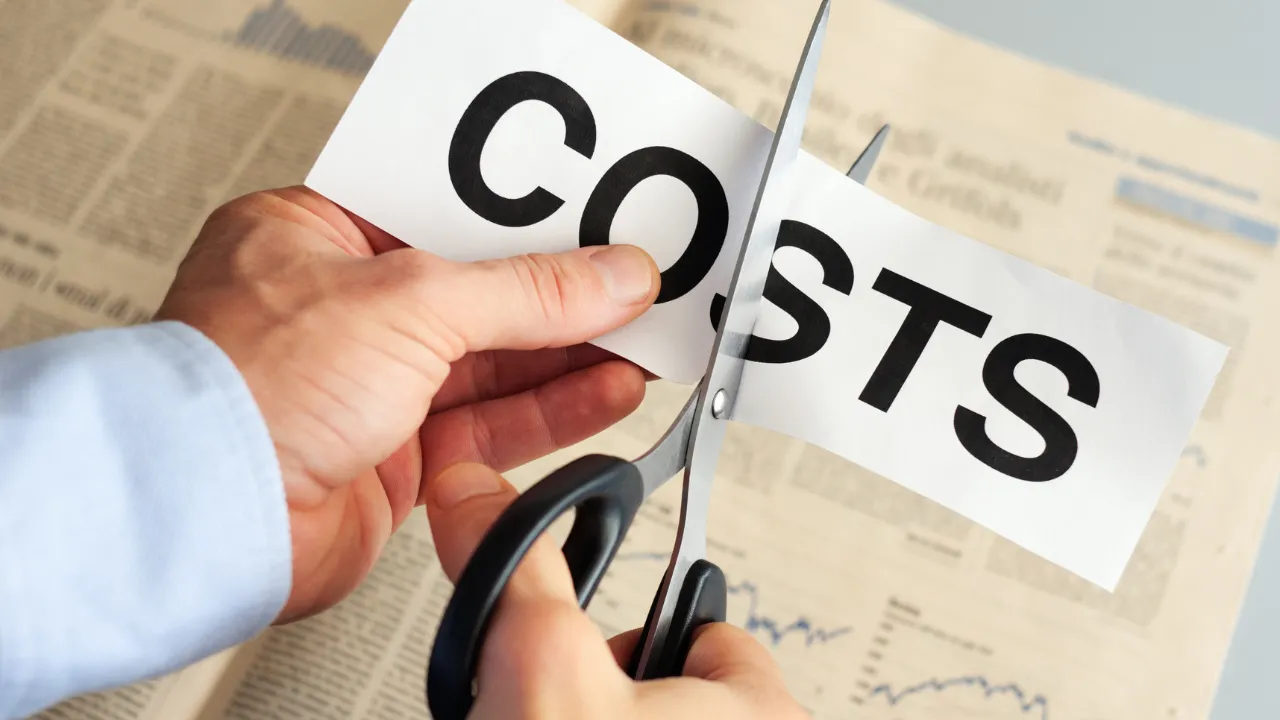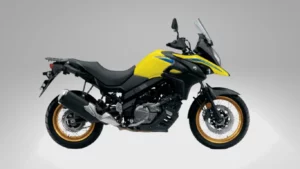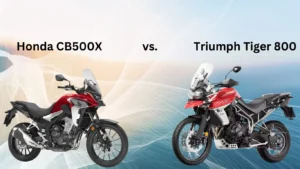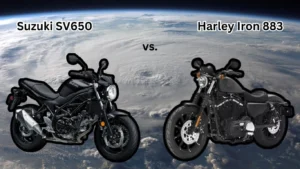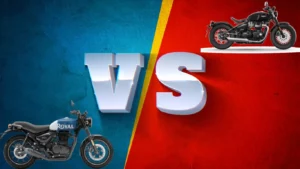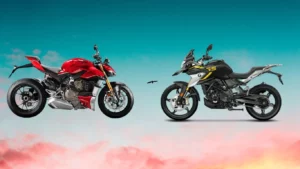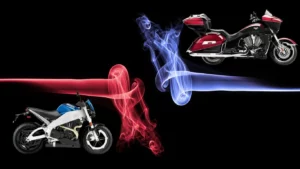The cost of a motorcycle can vary widely depending on the brand, model, and condition. A new motorcycle can cost anywhere from a few thousand dollars to tens of thousands of dollars, while a used motorcycle can range from a few hundred to several thousand dollars.
Here are some general price ranges for different types of motorcycles:
- Entry-level bikes: $2,500 to $5,000
- Standard bikes: $5,000 to $10,000
- Cruiser bikes: $7,000 to $20,000
- Adventure bikes: $10,000 to $20,000
- Sport bikes: $10,000 to $20,000
- Touring bikes: $15,000 to $30,000
Keep in mind that these prices are just estimates, and the actual cost of a motorcycle can vary depending on many factors, including the brand, model, year, mileage, condition, and location. It’s always a good idea to do some research and compare prices before making a purchase.
Factors on Which the Cost of a Motorcycle Depends?
The cost of a motorcycle depends on several factors, including:
1. Brand and Model
Brand and model are one of the most important factors that determine the cost of a motorcycle. Some popular motorcycle brands include Harley-Davidson, Yamaha, Honda, Suzuki, Kawasaki, BMW, and Ducati. These brands have different models, and the cost of each model can vary significantly based on the features, engine size, and other factors.
For example, Harley-Davidson is known for producing high-end cruisers with premium features, while Yamaha is known for producing sportbikes with advanced technology. BMW, on the other hand, is known for producing touring bikes with innovative features like electronic suspension.
Each brand has its own unique reputation, and the cost of a motorcycle from a particular brand can be influenced by its perceived value and market demand. In general, the more established and respected the brand, the higher the price of their motorcycles. Additionally, limited edition or special edition models can also have higher prices due to their exclusivity and rarity.
2. Engine Size
Engine size is a major factor that determines the cost of a motorcycle. Typically, the larger the engine size, the more expensive the motorcycle. Engine size is measured in cubic centimeters (cc) or liters (L).
Motorcycles with smaller engines, such as 125cc or 250cc models, are generally less expensive and are often used as beginner bikes or for commuting. On the other hand, motorcycles with larger engines, such as 1000cc or 1200cc models, are typically more expensive and are designed for more experienced riders who want more power and speed.
However, there are exceptions, as some high-end sportbikes can have smaller engines with high horsepower output, making them more expensive than some larger displacement bikes. Additionally, different types of motorcycles are designed for different purposes and may have different engine sizes. For example, touring bikes may have larger engines for increased comfort and long-distance travel, while dirt bikes may have smaller engines for better handling off-road.
In general, motorcycles with larger engines are more expensive due to the higher cost of manufacturing and the increased performance and power they offer. However, the cost of the motorcycle can also be influenced by other factors such as the brand, model, and features, as well as market demand and location.
3. Condition
The condition of a motorcycle is a major factor that determines its price. The condition of the motorcycle refers to its overall state, including the mileage, maintenance history, and general wear and tear. The two main categories of motorcycle condition are new and used.
New motorcycles are those that have never been owned or ridden and are in perfect condition. They are typically more expensive than used motorcycles due to their brand new state and the lack of previous ownership.
Used motorcycles can vary widely in condition, from excellent to poor. The price of a used motorcycle will depend on its age, mileage, and overall condition. Motorcycles with lower mileage and excellent maintenance records are generally more expensive than those with high mileage and poor maintenance.
The cosmetic condition of the motorcycle can also impact its price. A motorcycle with scratches, dents, or other cosmetic damage will typically be less expensive than one in pristine condition.
It’s important to note that the condition of the motorcycle can also impact its reliability and safety. A motorcycle in poor condition may require more repairs and maintenance, which can add to the overall cost of ownership. Before purchasing a used motorcycle, it’s important to inspect it thoroughly and take it for a test ride to ensure it’s in good working order.
4. Features
The features included on a motorcycle can also impact its price. Modern motorcycles come with a range of features that can enhance their performance, comfort, and safety. Some common features include:
Anti-lock brakes (ABS) – This feature prevents the wheels from locking up during hard braking, providing increased control and safety.
Electronic suspension – This advanced suspension system automatically adjusts the damping and preload to provide a smooth ride and improve handling.
Heated grips – This feature is designed to keep the rider’s hands warm during cold weather riding.
Cruise control – This feature allows the rider to set and maintain a constant speed without having to constantly adjust the throttle.
Traction control – This feature helps prevent the rear wheel from losing traction and skidding on slippery surfaces, providing improved safety.
Quick shifter – This feature allows for fast and seamless gear changes without having to use the clutch, providing improved performance.
GPS navigation – This feature provides turn-by-turn directions and helps riders find their way to new locations.
The more features a motorcycle has, the more expensive it is likely to be. However, some features may be more important to certain riders than others, depending on their individual preferences and riding style. As such, the cost of a motorcycle can also be influenced by the specific features that are included.
4. Accessories
Accessories are additional features that are not included as standard equipment on a motorcycle, but can be added by the owner or dealer. Some common accessories include:
Luggage – This can include saddlebags, top cases, and tank bags that are designed to provide additional storage for long-distance touring.
Windshield – This feature can provide increased wind protection and comfort for the rider.
Custom seats – These seats are designed to provide increased comfort and support for the rider.
Exhaust systems – Upgraded exhaust systems can improve performance and sound of the motorcycle.
LED lights – This feature can provide improved visibility and style.
Engine guards – These are designed to protect the engine and other critical components in the event of a crash.
Performance upgrades – These can include upgraded brakes, suspension, and engine components to enhance performance.
The cost of accessories can vary widely depending on the type and quality of the accessory. Some accessories can be relatively inexpensive, while others can add significant cost to the motorcycle. As with features, the cost of accessories can be influenced by the specific needs and preferences of the rider.
5. Market Demand
Market demand is another factor that can affect the cost of a motorcycle. If there is high demand for a particular make or model, the price is likely to be higher due to limited supply and increased competition among buyers. On the other hand, if there is low demand for a motorcycle, the price may be lower as sellers try to attract buyers with lower prices.
Factors that can influence market demand for motorcycles include:
Popularity – If a particular brand or model is popular among riders, it is likely to have higher demand and therefore a higher price.
Reputation – If a brand has a reputation for quality and reliability, it may have higher demand and a higher price.
Availability – If a motorcycle is rare or difficult to find, it may have higher demand and a higher price.
Economic conditions – Economic conditions can also impact market demand. Riders may spend more on a higher-priced motorcycle if the economy is good.
Geographic location – The location of the buyer and seller can also affect market demand. In some areas, certain types of motorcycles may be more popular or in higher demand than others.
Market demand is complex, impacted by brand reputation, popularity, availability, and economic situations. Hence, supply, demand, competition, and bargaining power can alter motorbike prices.
6. Location
The location where a motorcycle is being sold can also affect its cost. The cost of motorcycles can vary depending on where they are being sold due to factors such as taxes, transportation costs, and competition.
Here are some ways in which location can affect the cost of a motorcycle:
Taxes – Different states or countries have different tax rates, and this can affect the cost of a motorcycle. For example, in some states or countries, there may be additional sales taxes, registration fees, or other taxes that can add to the cost of a motorcycle.
Transportation costs – If the motorcycle is being sold in a remote area, it may be more expensive to transport it to the buyer. This can add to the overall cost of the motorcycle.
Competition – In some areas, there may be a higher concentration of motorcycle dealerships, which can increase competition and drive down prices.
Local demand – The local demand for a particular type of motorcycle can also affect its price. If there is high demand for a specific type of motorcycle in a particular area, the price may be higher.
Exchange rates – If the motorcycle is being imported or exported, exchange rates can also impact its cost. Fluctuations in exchange rates can lead to changes in the overall cost of the motorcycle.
the location where a motorcycle is being sold can impact its cost in various ways, and it’s important to consider these factors when purchasing a motorcycle.
Average Cost of a Brand New Motorcycle in US?
The average cost of a brand new motorcycle in the US can vary widely depending on the brand, model, and features included. According to the National Automobile Dealers Association (NADA), the average retail price of a new motorcycle in the US is around $13,500. However, this is just an average, and the cost of a new motorcycle can range from under $5,000 for a basic model to over $50,000 for a high-end sports or touring motorcycle with advanced features.
New motorbike prices depend on brand, model, engine size, features, location, and demand. Additionally, the cost of ownership, such as insurance, maintenance, and fuel expenses, should also be considered when purchasing a motorcycle.
Costs Included in New Motorcycles
The cost of a new motorcycle can include various items, such as:
The cost of owning a motorcycle doesn’t end after the initial purchase. Ongoing expenses such as insurance, maintenance, and repairs can add significantly to the cost of ownership over time. Additionally, some expenses, such as taxes and registration fees, can vary depending on the state or location. It’s important to factor in all of these costs when considering the total cost of a new motorcycle.
Base price
The base price of a new motorcycle refers to the cost of the motorcycle itself without any additional fees or charges. This is typically the starting point for negotiations when purchasing a motorcycle from a dealership or manufacturer. The base price can vary widely depending on the brand, model, and features included.
For example, a basic, entry-level motorcycle may have a base price of around $5,000 to $7,000, while a high-end sports or touring motorcycle with advanced features can have a base price of over $30,000. Additionally, custom or limited edition motorcycles can have even higher base prices.
The base price is just one factor to consider when purchasing a motorcycle. The overall cost of ownership should also include taxes, registration, insurance, and upkeep. Before buying, compare costs from multiple dealerships and negotiate the basic price.
Dealer fees
Dealer fees are charges that are added by the dealership on top of the base price of the motorcycle. These fees can include a variety of charges, such as documentation fees, freight charges, and preparation fees.
The dealership charges “doc fees” for paperwork and administrative tasks related to motorbike purchases. These fees can vary widely depending on the dealership and the state or region in which the dealership is located.
Freight charges are fees that cover the cost of shipping the motorcycle from the manufacturer to the dealership. These fees can also vary depending on the distance between the manufacturer and the dealership.
Preparation fees are charges that cover the cost of preparing the motorcycle for sale, such as assembly, inspection, and testing. These fees can also vary depending on the dealership and the type of motorcycle being sold.
Ask about and negotiate dealer fees, which can dramatically increase the motorcycle’s price. To discover the best bargain, investigate average dealer fees for the motorcycle you want and compare offers from multiple shops.
Taxes and registration fees
Taxes and registration fees are charges that are typically required by state or local government when purchasing a new motorcycle. The motorcycle’s value and state of purchase determine these fees.
Sales tax is a tax charged on the purchase price of the motorcycle and is typically based on the state or local tax rate. The tax rate can vary by state and can range from under 4% to over 10%.
Registration fees are fees charged by the state or local government for registering the motorcycle and obtaining license plates. These fees can vary depending on the state or region, and they may be based on the value or weight of the motorcycle.
Taxes and registration fees can add significantly to the overall cost of the motorcycle. It’s a good idea to research these fees before making a purchase, as they can vary depending on the state or region in which the motorcycle is purchased. Additionally, some dealerships may offer to handle the registration process for you for an additional fee, while others may require you to handle the registration process yourself.
Insurance
Motorcycle insurance is an important cost to consider when purchasing a new motorcycle. Most states need motorcycle insurance, and having enough to protect yourself and your bike is crucial.
The type of motorcycle, rider’s age and driving record, coverage level, and location all affect motorcycle insurance costs. Due to their higher repair and replacement costs, more expensive and powerful motorcycles have higher insurance rates.
Depending on the conditions above, motorbike insurance can cost a few hundred to over a thousand dollars per year. To discover the greatest coverage and pricing, compare insurance quotes.
It’s also worth noting that some dealerships may offer insurance packages or discounts for purchasing certain motorcycles or for bundling insurance with other services, such as financing or maintenance. To acquire the best coverage and pricing, you should study and compare insurance choices on your own.
Maintenance and repairs
Maintenance and repairs are important costs to consider when purchasing a new motorcycle. Like all vehicles, motorcycles require regular maintenance to keep them running smoothly and safely. This can include tasks such as oil changes, tire rotations, and brake inspections, among others.
The cost of maintenance and repairs can vary depending on the type of motorcycle, the frequency of maintenance, and the complexity of any required repairs. Some manufacturers offer maintenance packages or warranties that can help cover the cost of certain routine maintenance tasks for a set period of time or mileage.
It’s important to follow the manufacturer’s recommended maintenance schedule to keep your motorcycle in good working order and to avoid more costly repairs down the line. Additionally, it’s a good idea to budget for unexpected repairs, such as accidents or wear and tear on parts.
The cost of maintenance and repairs can also vary depending on whether you perform the tasks yourself or take your motorcycle to a dealership or mechanic.
DIY maintenance can save you money in the short term, but it’s important to have the knowledge and tools necessary to perform the tasks correctly and safely.
Taking your motorcycle to a dealership or mechanic can ensure that the work is done correctly, but it can be more expensive.
it’s important to factor in the cost of maintenance and repairs when budgeting for a new motorcycle, as these costs can add up over time.
Accessories and upgrades
Accessories and upgrades are another cost to consider when purchasing a new motorcycle. Many manufacturers offer optional accessories and upgrades that can enhance the functionality or appearance of the motorcycle, such as luggage racks, saddlebags, performance upgrades, or custom paint jobs.
The cost of accessories and upgrades can vary widely depending on the type and quality of the items. Engine guards and handguards are inexpensive, but custom wheels and exhaust systems are expensive.
It’s important to research and compare prices for accessories and upgrades before making a purchase, as prices can vary depending on the manufacturer or dealer. Some dealerships may offer package deals or financing options for accessories and upgrades, while others may offer discounts for bundling accessories with the purchase of a new motorcycle.
It’s also important to keep in mind that certain accessories or upgrades may affect the performance or safety of the motorcycle, so it’s important to do your research and consult with a professional before making any modifications.
Accessories and upgrades can be a fun and exciting way to personalize your motorcycle, but it’s important to budget for these costs and to make informed decisions about which accessories and upgrades are right for your needs and budget.
Additional Costs of A Motorcycle
In addition to the base price, dealer fees, taxes and registration fees, insurance, maintenance and repairs, and accessories and upgrades, there may be other costs associated with owning a motorcycle, depending on your situation. Here are a few examples:
1. Financing:
If you finance the purchase of your motorcycle, you’ll need to budget for monthly payments, interest charges, and any fees associated with the loan.
2. Storage:
If you don’t have a garage or other secure space to store your motorcycle, you may need to pay for storage at a facility or pay for a cover to protect your motorcycle from the elements.
3. Fuel:
Like all vehicles, motorcycles require fuel to operate, and the cost of fuel can vary depending on the price of gas in your area and the fuel efficiency of your motorcycle.
4. Riding gear:
Safety gear, such as helmets, jackets, gloves, and boots, is essential for protecting yourself while riding, and the cost of this gear can vary depending on the quality and brand.
5. Training:
If you’re a new rider or want to improve your skills, you may need to pay for motorcycle training courses or private lessons.
6. Parking:
Depending on where you live or travel, you may need to pay for parking in certain areas, such as city centers or parking garages.
It’s important to consider all of these costs when budgeting for a motorcycle, as they can add up quickly and impact your overall cost of ownership.
How to Save Money on a Motorcycle?
Here are some ways to save money on a motorcycle:
Consider buying used:
Buying a used motorcycle can often save you a significant amount of money compared to buying new. Just be sure to thoroughly inspect the motorcycle and research its history before making a purchase.
Negotiate with the dealer:
When buying a new motorcycle, it’s important to negotiate with the dealer to try to get the best price possible. You can also ask about any available incentives or promotions that can save you money.
Opt for a smaller engine: Motorcycles with smaller engines are often less expensive than those with larger engines. Choose a smaller engine according on your needs and riding style.
Take a motorcycle safety course:
Completing a motorcycle safety course can not only make you a safer rider, but it can also often qualify you for discounts on motorcycle insurance.
Shop around for insurance:
Be sure to shop around for motorcycle insurance to find the best rates and coverage for your needs. Consider factors such as deductibles, liability coverage, and optional coverage.
Learn to perform basic maintenance tasks:
Learning to perform basic maintenance tasks on your motorcycle, such as oil changes and tire rotations, can save you money on labor costs.
Plan ahead for accessories and upgrades:
If you plan to purchase accessories or upgrades for your motorcycle, research prices and look for deals or promotions to save money.
Research, negotiation, and DIY are needed to save money on a motorcycle.
Conclusion
Motorcycle prices depend on brand, model, engine size, condition, features, accessories, market demand, and location. In addition to the base price, other costs such as dealer fees, taxes and registration fees, insurance, maintenance and repairs, accessories and upgrades, financing, storage, fuel, riding gear, training, and parking should also be considered.
To save money on a motorcycle, consider buying used, negotiating with the dealer, opting for a smaller engine, taking a motorcycle safety course, shopping around for insurance, learning to perform basic maintenance tasks, and planning ahead for accessories and upgrades. With careful research and planning, you can find a motorcycle that fits your needs and budget.
